Tea Tasting Journal
As a kid, I have fond memories of my parents taking me to dim sum on weekends. I love dim sum to death! One thing I could not understand, however, was their insistence on ordering Pu’er or chrysanthemum tea to pair with the assortment of culinary delights. It puzzled me. Why would anyone drink this hot leaf water over the objectively superior iced water or Sprite? Back then, if you had asked me what type of tea I enjoyed, you’d be wasting your time. I only knew green, black, and the weird herbal ones that reminded me of perfume.
It all started with bubble tea. Of course I had heard of boba before, but I became absolutely obsessed in 2015, and it inflicted notable damage on my weight and diet plans. It became especially bad once I started working and had more disposable income. By 2021, I had tried most if not all of the notable bubble tea shops in the Bay Area. I had enough wherewithal to stop eventually. None of my pants fit me anymore, and it’s quite demoralizing to go shopping for new pants. Despite its deleterious effects on my health, bubble tea became a gateway drug for real tea: the ones with better quality, more subtle flavors, and infinitely less sugar.
I had very little interest in tea before my 20s. Now I can’t live without it. This blog documents my journey into the wonderful world of tea.
Tea (茶 - Chá)
“This tea is nothing more than just hot leaf juice!”
“Uncle, that’s what all tea is.”
-Conversation between Uncle Iroh and Prince Zuko in Avatar: The Last Airbender.
Tea drinking was first recorded in China in 59 BC, possibly earlier. The tea plant - Camellia sinensis - likely originated in Southwestern China in modern day Yunnan, near its borders with Myanmar. Ancient people ate tea before they started drinking it. Most tea drinking occurred for medicinal purposes.
Within China, tea drinking gained prominence during the Tang dynasty when the 8th century writer Lu Yu published a three volume treatise on tea called “The Classic of Tea” (780 CE). The book is divided into ten chapters and served as a seminal text in Chinese tea culture. It covered everything from ideal growing conditions, tools for harvesting and processing, best practices for preserving aroma and flavor, best utensils, brewing temperature, timing, and ratio, the various growing regions in China, the history and philosophy of tea drinking, and much more. The fastidiousness reminds me of third-wave coffee culture, except this was during the time of Middle Age Viking raids in Europe.
This amazing beverage simmered quietly in China for another 700 years before the Portuguese traders brought it to Europe in the 1500s. It became quite popular amongst the British Aristocracies, and then later to the broader public. The problem is the price of tea is still quite high. To break up China’s monopoly on tea production, the British successfully introduced tea cultivation in India in the 1800s; ending its reliance on China. Assam, Darjeeling, and Ceylon teas are all named after regions in and around India. By the 19th century, large quantities of tea from India meant it had become an everyday beverage for all classes of society.
The history of tea is very interesting and worth a read. Tea played a central role in two major historical events that shaped the modern world. The Boston Tea Party of 1773 was a pivotal moment in US history. Whereas the Opium War of 1839 was a pivotal moment in Chinese history. The former was caused by Britain’s export tax on tea shipped to the US. The latter was caused by the lucrative opium trade which was initially introduces as a way to alleviate Britain’s trade deficit with China. The former lead to the creation of a new nation; the latter the decline of an antiquated empire.
The rabbit hole for tea-drinking culture is deep. This is an area of interest that goes back thousands of years! I am not a tea expert. I like tea, but I also like simplicity. Short of ordering test kits on Amazon to measure water hardness and pH levels, here are some general pointers that gets you 80% of the way there with 20% of the effort. Or just drink tea “Grandpa Style”.
- Good quality water can make a difference - Use cold filtered or spring water, not to hard (too much mineral content), and not too soft (flat distilled water). Do not boil water more than once.
- Ideal brew temperature depends on level of oxidation. Cooler water highlights sweetness but may not fully extract darker teas, while hotter water brings out flavors but can over-extract lighter teas leading to excessive astringency and bitterness. Here’s a rough rule of thumb:
- Green (80° C)
- Oolong (90° C)
- Dark (100° C)
- Adjust steep time and water-tea ratio according to your taste. You can find specific recommendations online. At the end of the day, you should find what works for you. Some prefer lighter while others prefer stronger. Some brew one big batch in a teapot, while others prefer multiple infusions with gaiwan. It’s easy to brew tea. Don’t overcomplicate things. For one pot steeping, steep time can vary from 2-5 minutes, and ratio can vary from 2-4g of tea per cup (240 mL). Some teas are more forgiving than others.
I will be sampling 14 different tea varieties I bought from Cha Mood. You can probably find something cheaper and better locally within the US. I liked their website design which is why I bought from them.
 Tea Sampler Set From Cha Mood
Tea Sampler Set From Cha Mood
Personal ratings:
| Tea | Rating/5 | Description of Taste |
|---|---|---|
| Moonlight White | ⭐⭐⭐ | Light, elegant floral tea with a hint of sweetness. Strong taste of honey. |
| White Peony (Baimudan) | ||
| Maofeng Green | ⭐⭐⭐ | Grassy, nutty umami with hint of sweet potato. |
| Long Jing Green | ||
| Jin Xuan (Milky) Oolong | ⭐⭐⭐⭐ | A lighter Oolong. Very smooth, buttery, and silky. No astringency at all. I am not convinced it tastes like milk though. |
| Dong Ding Oolong | ⭐⭐⭐⭐⭐ | A richer and toastier Oolong taste. Like roasted almond. It has a woody note that kind of reminds me of fresh paper. |
| Honey Orchid Oolong | ||
| Alishan Oolong | ||
| Tie Guan Yin Oolong | ||
| Ya Shi Xiang Oolong | ||
| Da Hong Pao Oolong | ||
| Dian Hong Red | ⭐⭐⭐⭐⭐ | Light sweetness like Moonlight white but with more complexity. Malty. Hints of dried fruit like raisin or plum. No astringency at all. |
| Lapsang Souchong Black | ||
| Raw Pu’er | ||
| Ancient Tree Pu’er |
Moonlight White (月光白 - Yuè guāng bái)
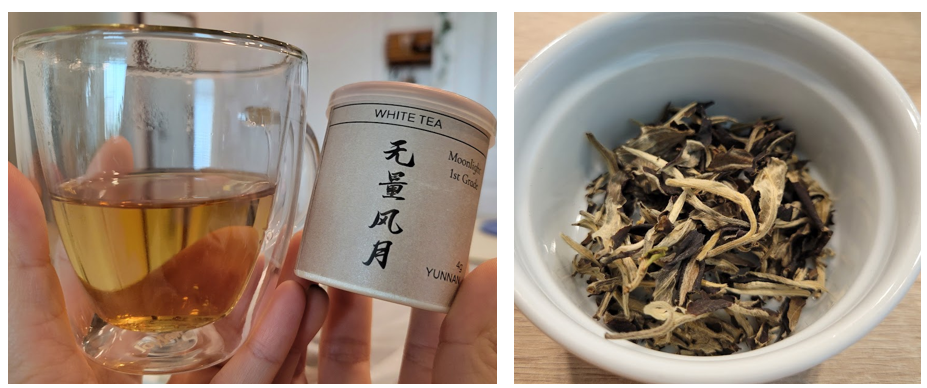
Moonlight white tea is produced in the Yunnan province of China. It is picked annually in April. Because it is produced in the same place as Pu’er tea, some people call this tea “white Pu’er”. The leaf buds are crescent shaped like the moon with one side white, and the other dark.
The taste is light, mild, with a floral sweetness that resembles honey. Imagine how honey-water would taste with 1% of its sweetness. This tea is very easy to brew. Astringency and sourness does creep in on longer brews. There is a Chinese phrase that I think perfectly describes Moonlight white: 淡雅花香小甜茶 (light and elegant floral tea with a hint of sweetness).
Mao Feng Green Tea (毛峰 - máo fēng)
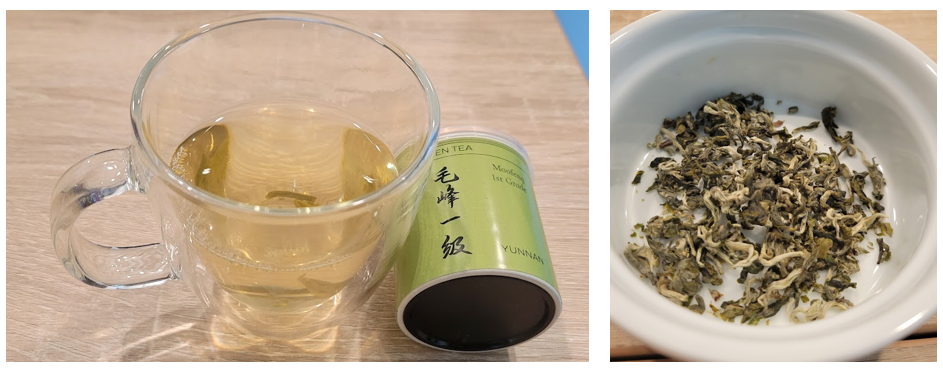
Mao Feng green tea is produced Anhui province of China, typically near Huangshan (yellow mountain). It is one of the most well-known green tea variety in China. 毛峰 (mao feng) can be translated as fur peak, which refers to the tiny white hair on the tea leaves.
The taste is grassy and nutty and reminds me of Long Jing green tea. There is also a noticeable hint of sweet potato. I read online that maofeng is incredibly forgiving and can be brewed forever without becoming astringent and bitter. This was definitely not the case for the ones I bought. I think I would prefer a lighter brew. I will add less leaves next time.
Dong Ding Oolong Tea (凍頂 - Dòng Dǐng)
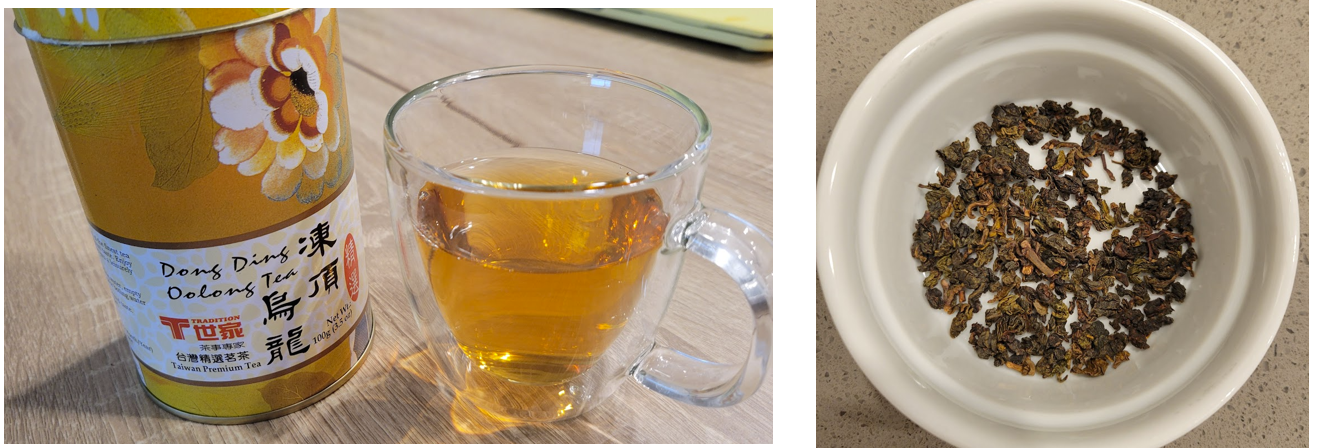
Dong Ding oolong tea is produced in Taiwan and named after the mountain where it is cultivated, near Lugu Township, Nantou. Because of its popularity and demand, Dong Ding oolong is now grown all over Taiwan. The original Dong Ding plants were brought to Taiwan from the Wuyi Mountains in China’s Fujian Province 150 years ago. Since then, it has been refined through annual competitions. The Lugu farmer’s association, and the Dong Ding Tea Cooperative are both bodies that run annual competitions for this variety. Compared to other high-mountain oolong teas from Taiwan, the Dong Ding mountain is only around 600 to 900 m (compared to Alishan at 1300m and Lishan at 2000m). Dong Ding translates to “icy peak” or “frozen summit”.
I think I’m most familiar with Dong Ding oolong which might explain my fondness for it. The taste is rich and toasty, like roasted almond. It’s stronger than lighter varieties like Jin Xuan. It has a woody note that kind of reminds me of fresh envelope paper.
Jin Xuan (Milky) Oolong Tea (金萱 - jīn xuān)
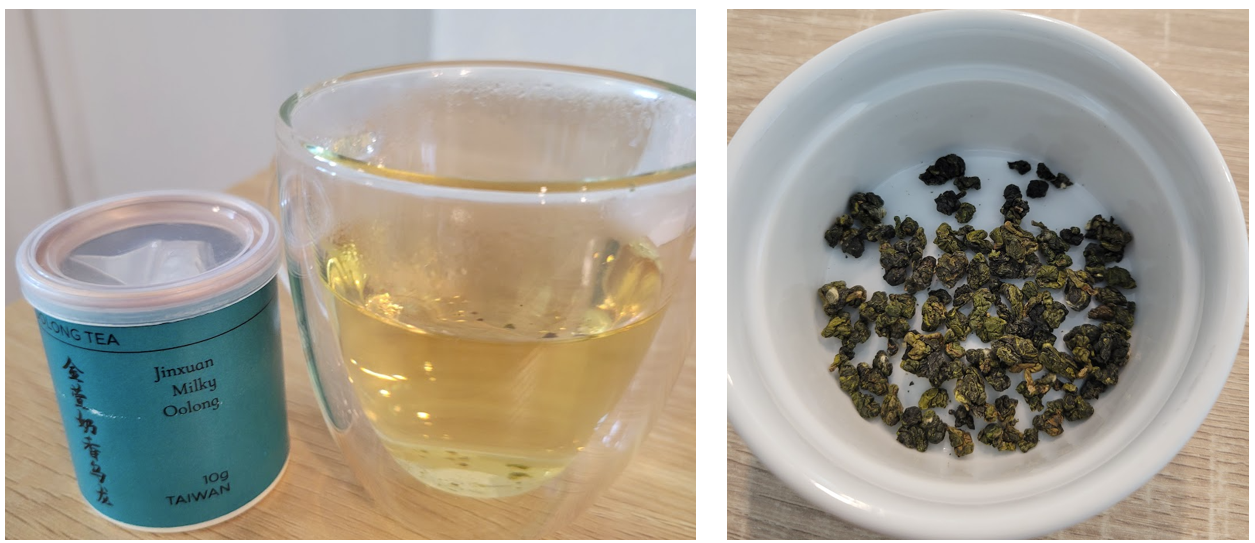
Unlike the more traditional oolongs like Tie Guan Yin or Da Hong Pao, Jin Xuan is a relatively new cultivar of oolong tea produced in Taiwan. It was cultivated by the Taiwan Research and Extension Station of Taiwan (TRES) in the 1980s through careful selective breeding.
Jin Xuan was named after the grandmother of its creator, Wu Zhenduo, who many consider to be the father of Taiwanese tea. His goal was to create a tea plant that was resistant to diseases, high-yielding, and flavorful. Nowadays, Jin Xuan the third most popular cultivar in Taiwan is grown all over Taiwan, particularly in regions such as Nantou, Chiayi, and Miaoli. This variety of oolong is known for its naturally creamy, buttery taste, which is why it’s also known as “Milky oolong”.
I think this variety of oolong is quite light compared to the other ones I’ve tasted. It’s smooth, buttery, and silky. No astringency at all. Although it is quite smooth, I am not convinced it tastes like milk, and I prefer oolong with a darker note.
Dian Hong Red Tea (滇紅 - Diān hóng)
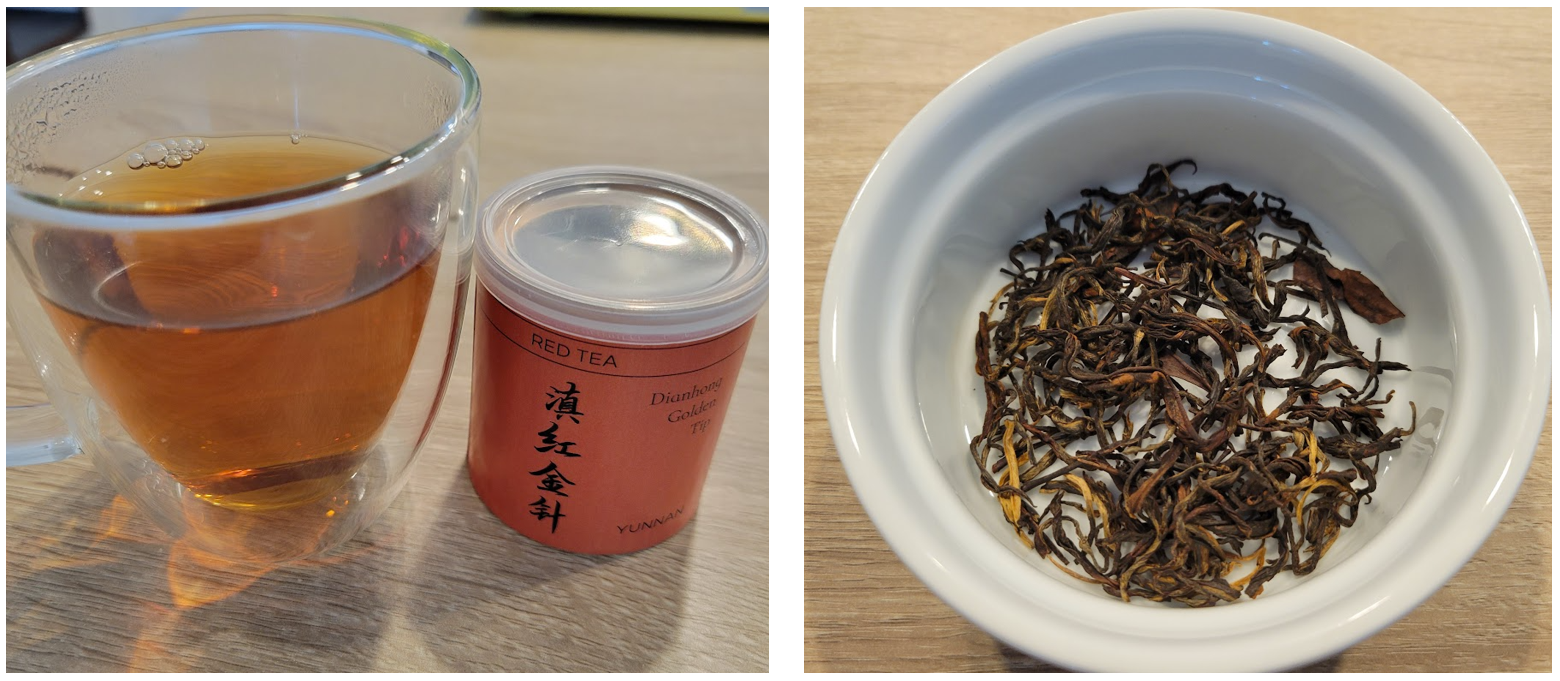
Dian Hong red tea is a relatively new cultivar created in the 1930s in the mountainous canyon area west of the Lancang River and east of the Nujiang River in southwestern Yunnan. It enjoys a gourmet, high-end reputation in former Soviet Union, Eastern Europe, and London. The word 滇 (dian) is a short name for Yunnan, whereas the word 紅 (hong) means red. As such, Dian Hong is often referred to as Yunnan red, or Yunnan black tea. As a sidenote, Western audiences usually categorize tea as either green or black. In China, there are actually three tea categories in common parlance: green, red, and black. Black is used exclusively to describe fermented tea such as Pu’er.
Visually speaking, the tea leaves are a mix of dark and striking golden tips. After brewing, the liquid turns into a deep reddish orange that is incredibly appealing. It smells sweeter than it tastes. The taste is similar to Moonlight white. There is a hint of floral sweetness. But unlike the moonlight white tea, there is a malty note that reminds me of dried fruit like raisin or plum.
TO BE CONTINUED…
Comments